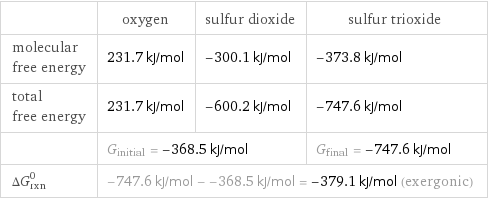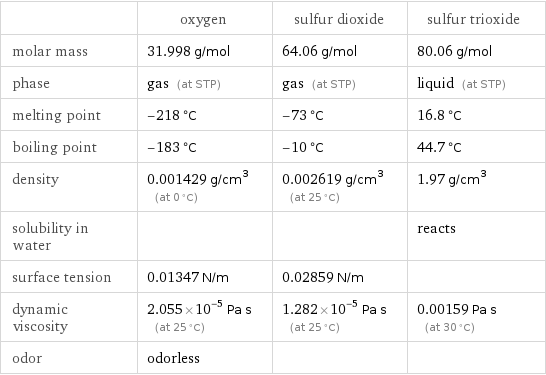Input interpretation

O_2 (oxygen) + SO_2 (sulfur dioxide) ⟶ SO_3 (sulfur trioxide)
Balanced equation

Balance the chemical equation algebraically: O_2 + SO_2 ⟶ SO_3 Add stoichiometric coefficients, c_i, to the reactants and products: c_1 O_2 + c_2 SO_2 ⟶ c_3 SO_3 Set the number of atoms in the reactants equal to the number of atoms in the products for O and S: O: | 2 c_1 + 2 c_2 = 3 c_3 S: | c_2 = c_3 Since the coefficients are relative quantities and underdetermined, choose a coefficient to set arbitrarily. To keep the coefficients small, the arbitrary value is ordinarily one. For instance, set c_1 = 1 and solve the system of equations for the remaining coefficients: c_1 = 1 c_2 = 2 c_3 = 2 Substitute the coefficients into the chemical reaction to obtain the balanced equation: Answer: | | O_2 + 2 SO_2 ⟶ 2 SO_3
Structures

+ ⟶
Names

oxygen + sulfur dioxide ⟶ sulfur trioxide
Reaction thermodynamics
Gibbs free energy

| oxygen | sulfur dioxide | sulfur trioxide molecular free energy | 231.7 kJ/mol | -300.1 kJ/mol | -373.8 kJ/mol total free energy | 231.7 kJ/mol | -600.2 kJ/mol | -747.6 kJ/mol | G_initial = -368.5 kJ/mol | | G_final = -747.6 kJ/mol ΔG_rxn^0 | -747.6 kJ/mol - -368.5 kJ/mol = -379.1 kJ/mol (exergonic) | |
Equilibrium constant
![Construct the equilibrium constant, K, expression for: O_2 + SO_2 ⟶ SO_3 Plan: • Balance the chemical equation. • Determine the stoichiometric numbers. • Assemble the activity expression for each chemical species. • Use the activity expressions to build the equilibrium constant expression. Write the balanced chemical equation: O_2 + 2 SO_2 ⟶ 2 SO_3 Assign stoichiometric numbers, ν_i, using the stoichiometric coefficients, c_i, from the balanced chemical equation in the following manner: ν_i = -c_i for reactants and ν_i = c_i for products: chemical species | c_i | ν_i O_2 | 1 | -1 SO_2 | 2 | -2 SO_3 | 2 | 2 Assemble the activity expressions accounting for the state of matter and ν_i: chemical species | c_i | ν_i | activity expression O_2 | 1 | -1 | ([O2])^(-1) SO_2 | 2 | -2 | ([SO2])^(-2) SO_3 | 2 | 2 | ([SO3])^2 The equilibrium constant symbol in the concentration basis is: K_c Mulitply the activity expressions to arrive at the K_c expression: Answer: | | K_c = ([O2])^(-1) ([SO2])^(-2) ([SO3])^2 = ([SO3])^2/([O2] ([SO2])^2)](../image_source/75f7dcd96672422b0d002cbc5dd0338a.png)
Construct the equilibrium constant, K, expression for: O_2 + SO_2 ⟶ SO_3 Plan: • Balance the chemical equation. • Determine the stoichiometric numbers. • Assemble the activity expression for each chemical species. • Use the activity expressions to build the equilibrium constant expression. Write the balanced chemical equation: O_2 + 2 SO_2 ⟶ 2 SO_3 Assign stoichiometric numbers, ν_i, using the stoichiometric coefficients, c_i, from the balanced chemical equation in the following manner: ν_i = -c_i for reactants and ν_i = c_i for products: chemical species | c_i | ν_i O_2 | 1 | -1 SO_2 | 2 | -2 SO_3 | 2 | 2 Assemble the activity expressions accounting for the state of matter and ν_i: chemical species | c_i | ν_i | activity expression O_2 | 1 | -1 | ([O2])^(-1) SO_2 | 2 | -2 | ([SO2])^(-2) SO_3 | 2 | 2 | ([SO3])^2 The equilibrium constant symbol in the concentration basis is: K_c Mulitply the activity expressions to arrive at the K_c expression: Answer: | | K_c = ([O2])^(-1) ([SO2])^(-2) ([SO3])^2 = ([SO3])^2/([O2] ([SO2])^2)
Rate of reaction
![Construct the rate of reaction expression for: O_2 + SO_2 ⟶ SO_3 Plan: • Balance the chemical equation. • Determine the stoichiometric numbers. • Assemble the rate term for each chemical species. • Write the rate of reaction expression. Write the balanced chemical equation: O_2 + 2 SO_2 ⟶ 2 SO_3 Assign stoichiometric numbers, ν_i, using the stoichiometric coefficients, c_i, from the balanced chemical equation in the following manner: ν_i = -c_i for reactants and ν_i = c_i for products: chemical species | c_i | ν_i O_2 | 1 | -1 SO_2 | 2 | -2 SO_3 | 2 | 2 The rate term for each chemical species, B_i, is 1/ν_i(Δ[B_i])/(Δt) where [B_i] is the amount concentration and t is time: chemical species | c_i | ν_i | rate term O_2 | 1 | -1 | -(Δ[O2])/(Δt) SO_2 | 2 | -2 | -1/2 (Δ[SO2])/(Δt) SO_3 | 2 | 2 | 1/2 (Δ[SO3])/(Δt) (for infinitesimal rate of change, replace Δ with d) Set the rate terms equal to each other to arrive at the rate expression: Answer: | | rate = -(Δ[O2])/(Δt) = -1/2 (Δ[SO2])/(Δt) = 1/2 (Δ[SO3])/(Δt) (assuming constant volume and no accumulation of intermediates or side products)](../image_source/827dfdf59308851c0e07f6ca12481ccf.png)
Construct the rate of reaction expression for: O_2 + SO_2 ⟶ SO_3 Plan: • Balance the chemical equation. • Determine the stoichiometric numbers. • Assemble the rate term for each chemical species. • Write the rate of reaction expression. Write the balanced chemical equation: O_2 + 2 SO_2 ⟶ 2 SO_3 Assign stoichiometric numbers, ν_i, using the stoichiometric coefficients, c_i, from the balanced chemical equation in the following manner: ν_i = -c_i for reactants and ν_i = c_i for products: chemical species | c_i | ν_i O_2 | 1 | -1 SO_2 | 2 | -2 SO_3 | 2 | 2 The rate term for each chemical species, B_i, is 1/ν_i(Δ[B_i])/(Δt) where [B_i] is the amount concentration and t is time: chemical species | c_i | ν_i | rate term O_2 | 1 | -1 | -(Δ[O2])/(Δt) SO_2 | 2 | -2 | -1/2 (Δ[SO2])/(Δt) SO_3 | 2 | 2 | 1/2 (Δ[SO3])/(Δt) (for infinitesimal rate of change, replace Δ with d) Set the rate terms equal to each other to arrive at the rate expression: Answer: | | rate = -(Δ[O2])/(Δt) = -1/2 (Δ[SO2])/(Δt) = 1/2 (Δ[SO3])/(Δt) (assuming constant volume and no accumulation of intermediates or side products)
Chemical names and formulas

| oxygen | sulfur dioxide | sulfur trioxide formula | O_2 | SO_2 | SO_3 Hill formula | O_2 | O_2S | O_3S name | oxygen | sulfur dioxide | sulfur trioxide IUPAC name | molecular oxygen | sulfur dioxide | sulfur trioxide
Substance properties

| oxygen | sulfur dioxide | sulfur trioxide molar mass | 31.998 g/mol | 64.06 g/mol | 80.06 g/mol phase | gas (at STP) | gas (at STP) | liquid (at STP) melting point | -218 °C | -73 °C | 16.8 °C boiling point | -183 °C | -10 °C | 44.7 °C density | 0.001429 g/cm^3 (at 0 °C) | 0.002619 g/cm^3 (at 25 °C) | 1.97 g/cm^3 solubility in water | | | reacts surface tension | 0.01347 N/m | 0.02859 N/m | dynamic viscosity | 2.055×10^-5 Pa s (at 25 °C) | 1.282×10^-5 Pa s (at 25 °C) | 0.00159 Pa s (at 30 °C) odor | odorless | |
Units
